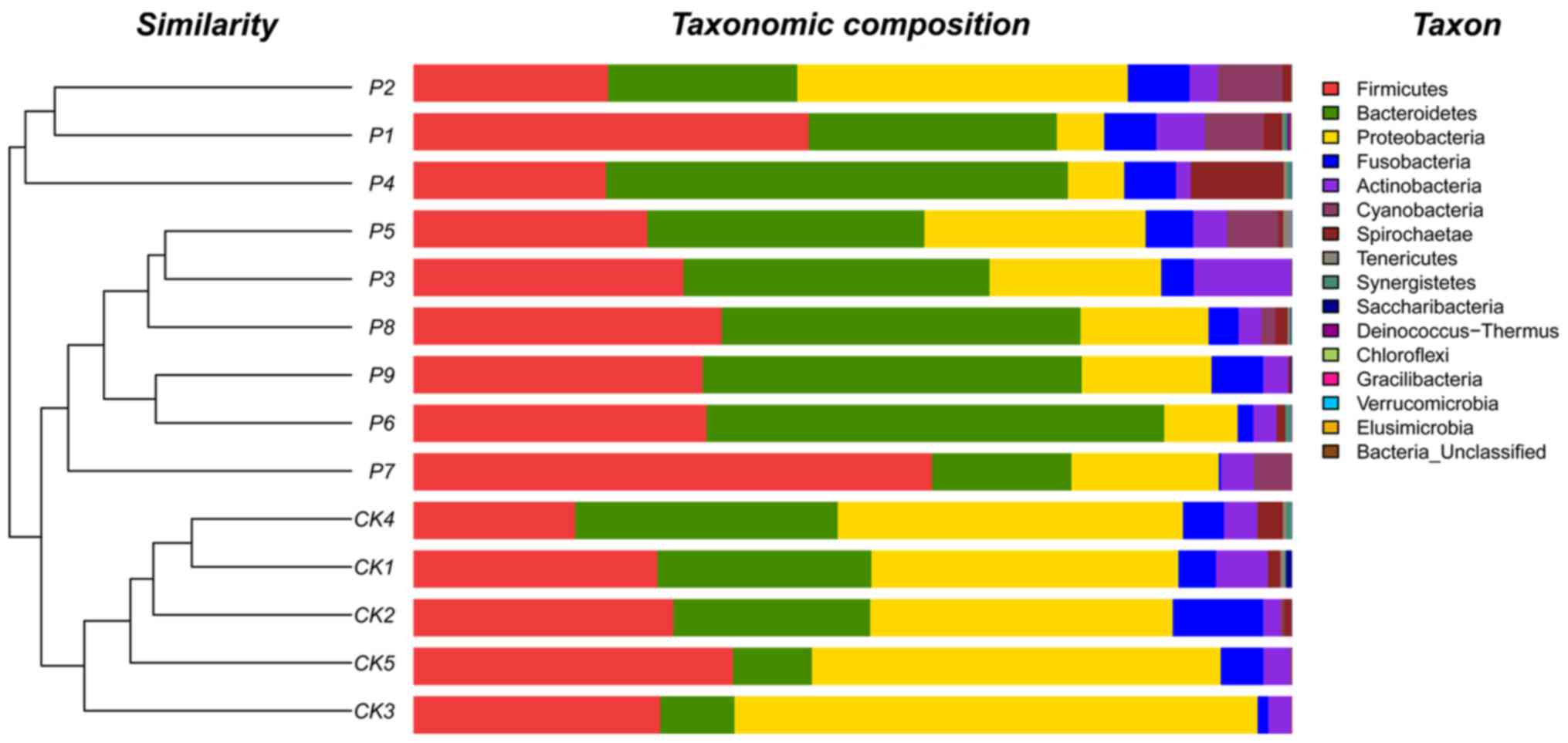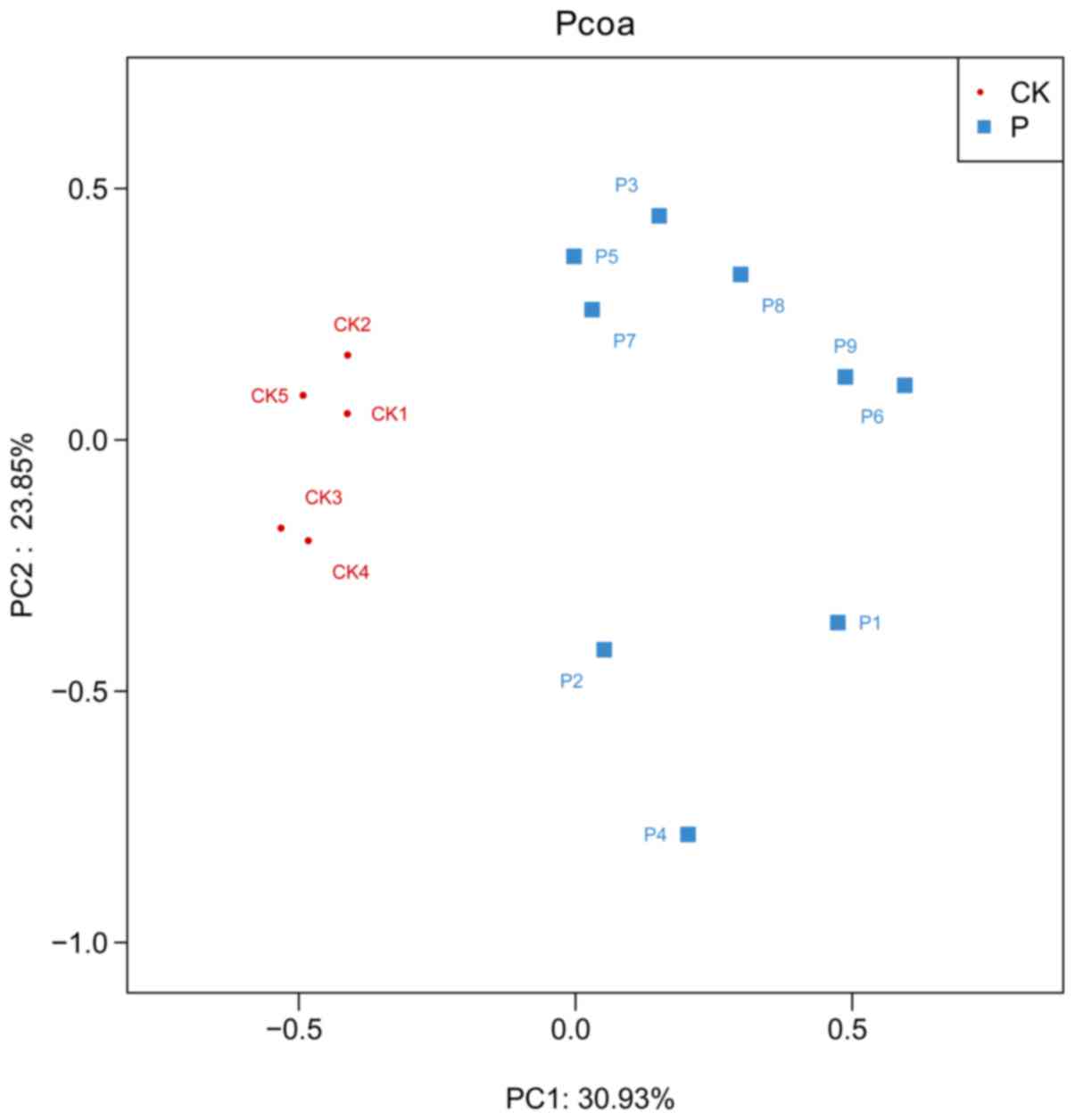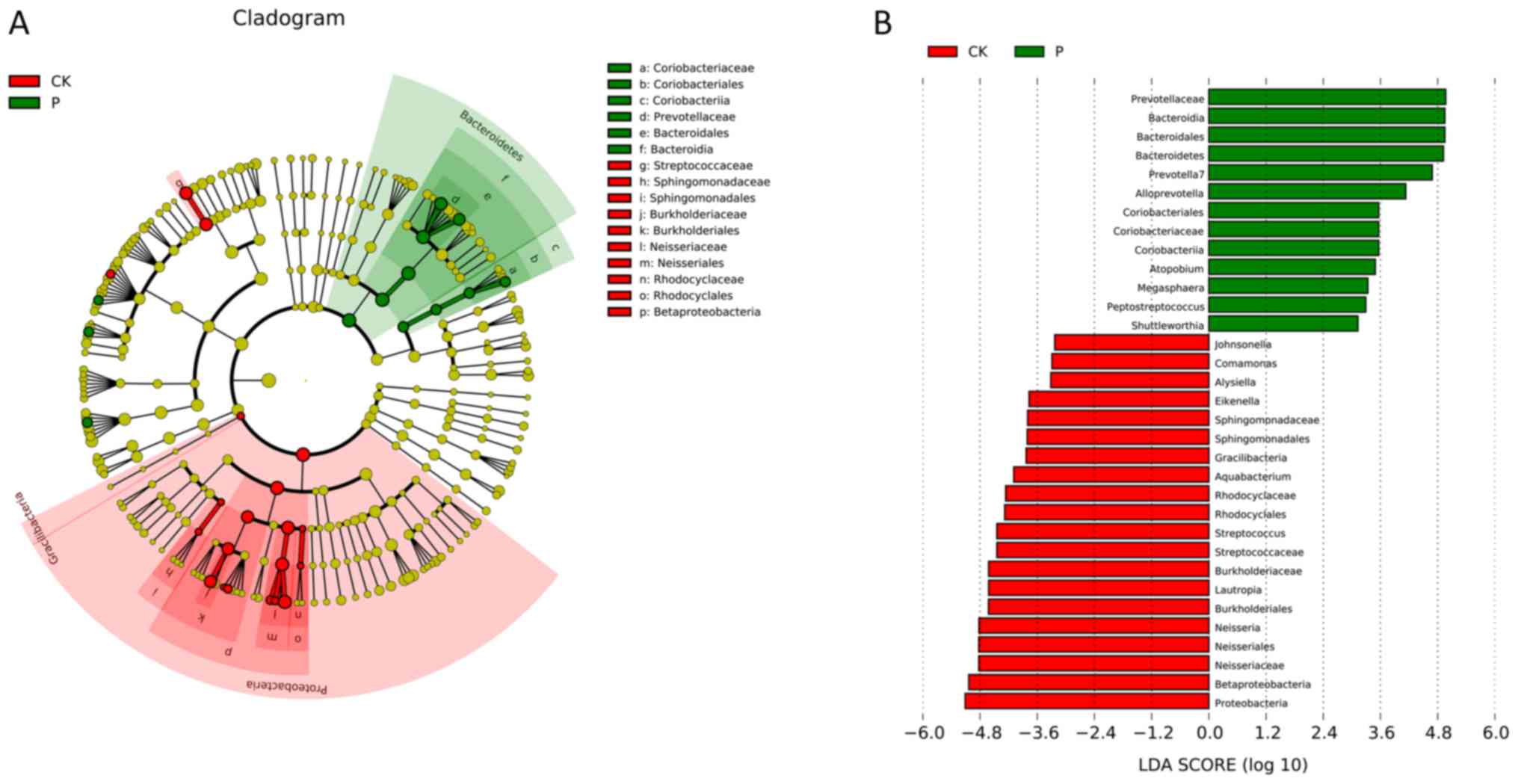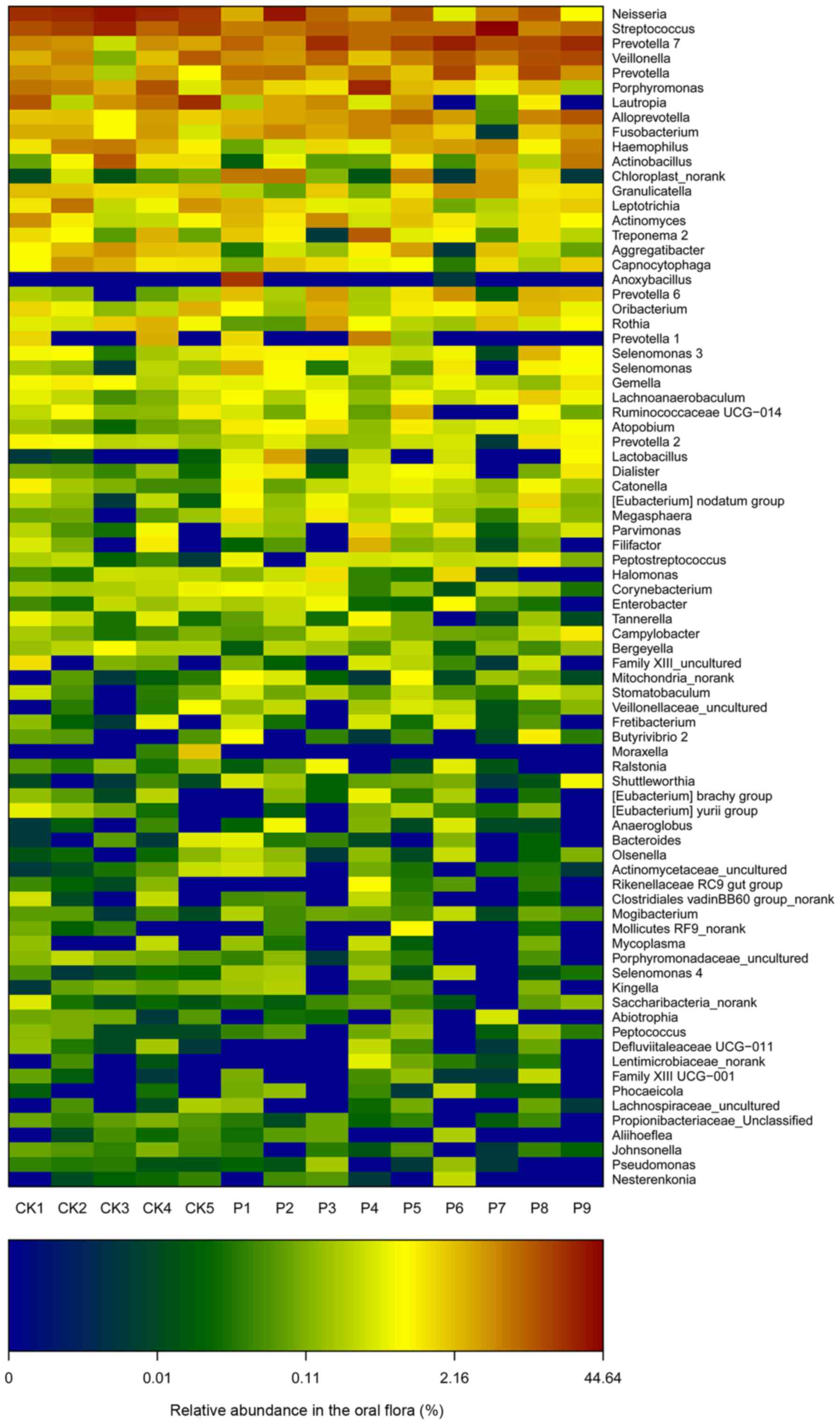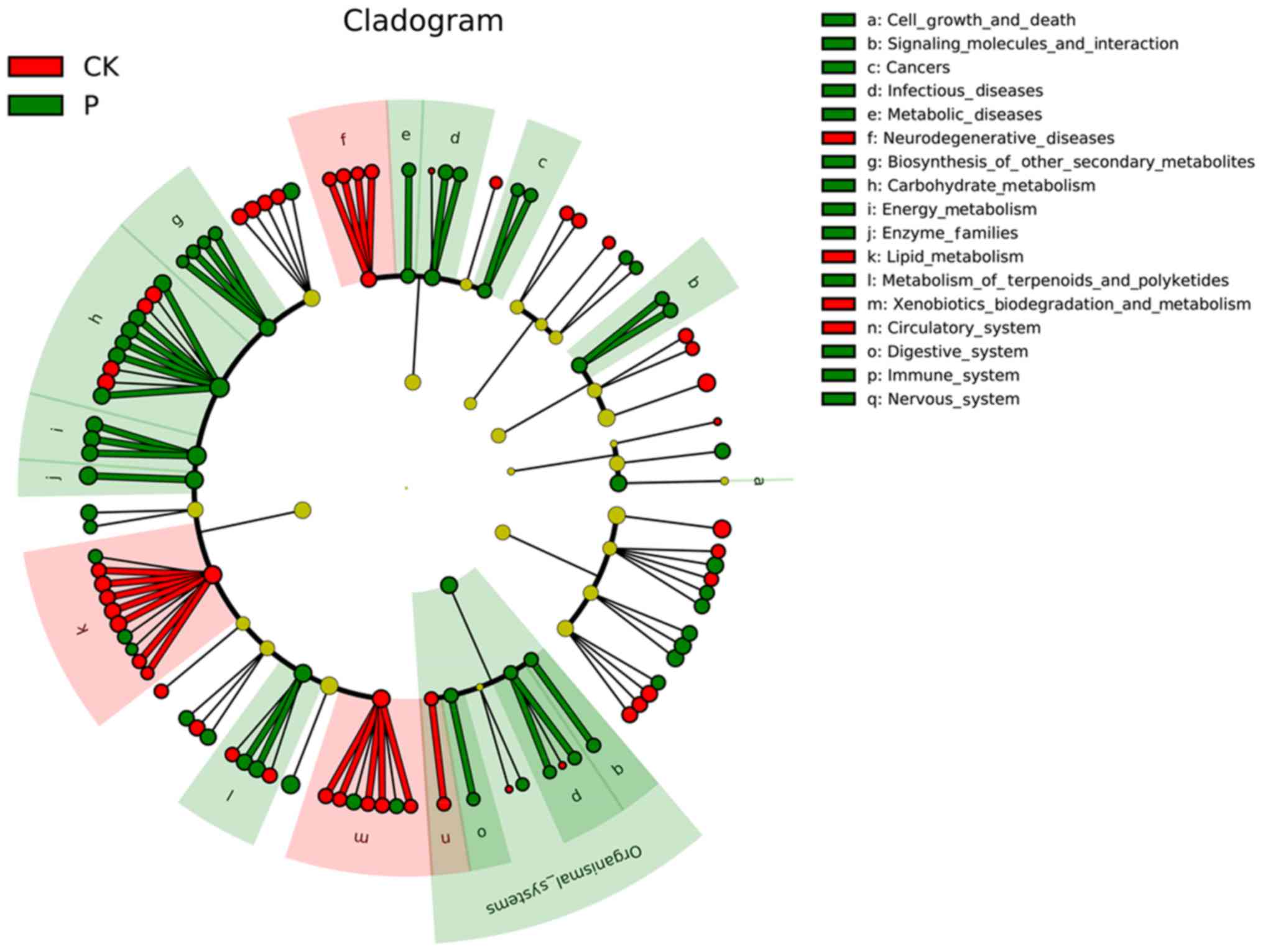Oral microbial flora of patients with Sicca syndrome
- Authors:
- Published online on: September 27, 2018 https://doi.org/10.3892/mmr.2018.9520
- Pages: 4895-4903
-
Copyright: © Zhou et al. This is an open access article distributed under the terms of Creative Commons Attribution License.
Abstract
Introduction
Sicca syndrome (SS), also known as Sjögren's syndrome, is a systemic autoimmune disease that mainly affects the exocrine glands, including salivary and lacrimal glands. In SS, the local tissue is infiltrated with lymphocytes, affecting the normal function of the glands (1). SS that is not accompanied by any other autoimmune diseases is called primary SS (pSS). Its exact etiology and pathogenesis remain elusive, and no cure is currently available for this disease (2). At present, environmental factors are considered to have an important role in pSS (3). Multiple studies have demonstrated that various infectious factors in the environment, including Helicobacter pylori, Epstein-Barr virus and Mycoplasma, are closely associated with the occurrence and development of pSS (4).
The clinical manifestations of pSS are complex. Altered salivary gland function typically causes xerostomia with significantly reduced saliva, which changes the inherent balance of the oral microbial flora (5). Microbes occur in large numbers in the oral cavity. The saliva comprises a variety of proteins, enzymes and antibodies, which help lubricate and clean the mouth and regulate the pH. Hence, it is vital in controlling the location of microbes on the surface of teeth and soft tissues (6). Primary SS may increase the odds of acquiring microbial diseases, including caries and periodontal disease. Epidemiological data have indicated that the incidence of caries was significantly higher in patients with pSS than that in the healthy population (7). Previous studies analyzing typical pathogenic microbes in oral samples from patients with pSS have demonstrated that the numbers of Lactobacillus and Actinomyces are significantly different in patients with pSS compared with those in healthy populations (8). Selective media are usually used to identify culturable microbial organisms. At present, the composition and changes in the oral microbial flora in pSS, as well as the role of bacteria in the pathogenesis of this autoimmune disease, are poorly understood. It is important to investigate the composition of the oral microbial flora of patients with pSS and comprehensively analyze changes compared to healthy individuals, in order to provide guidance for the clinical treatment of pSS.
The aim of the present study was to assess differences in the composition of the oral microbial flora of patients with pSS and healthy individuals in China using high-throughput sequencing (HTS) (9) and provide a reference for treatment strategies.
Patients and methods
Patients and controls
According to the new diagnostic criteria published by the American College of Rheumatology in 2012 based on a cohort study of the Sjögren's International Collaborative Clinical Alliance (5), nine patients with pSS were selected whose clinical manifestations were in accordance with at least two of the three diagnostic criteria (Table I). The patients with pSS were newly diagnosed cases with no previous treatment, no antibiotic use in the last 3 months and no systemic diseases, including hepatitis, tuberculosis and diabetes. Dental and periodontal diseases were eliminated through oral examination. A total of five individuals without any oral diseases were selected as the healthy control group. pSS is more common in females (10); therefore, female healthy individuals and patients were selected in order to avoid sex bias. No significant difference in age was present between the pSS and control group. The mean age of the patient and control group was 51.4 and 50.5 years, respectively (P=0.795).
Patients with pSS and healthy controls were selected by professional immunologists and dentists according to the new diagnostic criteria. Saliva samples from nine patients with pSS and five healthy volunteers were assessed by HTS using the Illumina MiSeq platform (Illumina, Inc., San Diego, CA, USA), which was performed by Shanghai Biozeron Co., Ltd. (Shanghai, China). Written informed consent was provided by all patients and healthy volunteers. The study was approved by the Medical Ethics Committee of Nanjing Stomatological Hospital (Nanjing, China). All procedures were performed in accordance with the relevant guidelines and regulations.
Sample collection
The patients with pSS and controls were instructed to rinse their mouth with water and requested not to consume any food or water, to smoke or use chewing gum for 30 min prior to saliva collection. Saliva was collected using a collector kit (cat. no. 401001; Xiamen Zhishan Biotechnology Co., Ltd., Fujian, China) according to the manufacturer's protocol, mixed with 1:1 saliva storage solution and stored at room temperature (a sealed tube and the storage solution were provided in the collector kit, with no requirement for cryopreservation; DNA integrity was good and no degradation was observed).
DNA extraction and purification
Microbial DNA was extracted from the 14 saliva samples using the E.Z.N.A. stool DNA kit (cat. no. D4015-02; Omega BioTek, Inc., Norcross, GA, USA) according to the manufacturer's protocols and purified using the MoBioPowerClean DNA Clean-up kit (cat. no. 12877-50; MoBio Laboratories Inc., Carlsbad, CA, USA). Subsequently, the purified genomic DNA was detected using 1% agarose gel electrophoresis.
Polymerase chain reaction (PCR) amplification, product quantification and homogenization
The V4-V5 region of the gene encoding for the bacterial 16S ribosomal RNA was amplified with the specific barcode primers by PCR using an ABI GeneAmpMidel 9700 amplifier (Applied Biosystems; Thermo Fisher Scientific, Inc., Waltham, MA, USA). The thermocycling conditions were as follows: 95°C for 2 min, followed by 27 cycles of denaturation for 95°C for 30 sec, annealing at 55°C for 30 sec and extension at 72°C for 30 sec, and a final extension at 72°C for 5 min. The primers 515F 5′-barcode-GTGCCAGCMGCCGCGG-3′ and 907R 5′-CCGTCAATTCMTTTRAGTTT-3′, where the barcode is an eight-base sequence unique to each sample, were used. PCR was performed using TransGen AP221-02 (TransGen Biotech Co., Ltd, Beijing, China) with TransStart FastPfu DNA Polymerase in a 20-µl mixture containing 4 µl 5XFastPfu Buffer, 2 µl 2.5 mM deoxynucleoside triphosphates, 0.8 µl of each primer (5 µM), 0.4 µl FastPfu Polymerase and 10 ng template DNA. All experiments were performed in triplicate according to standard procedures. The PCR products from each tagged primer were pooled and detected using 2% agarose gel electrophoresis. The PCR products were excised from the gel and isolated with an AxyPrep DNA Gel Extraction kit (cat. no. AP-GX-250; Axygen Biosciences, Union City, CA, USA), eluted with Tris HCl and detected using 2% agarose gel electrophoresis. Finally, according to the preliminary results of the electrophoresis, the PCR products were quantified using QuantiFluor ST (Promega Corp., Madison, WI, USA) according to the manufacturer's protocols and then mixed according to the quantity requirement for sequencing of each sample.
Sequencing data optimization
For data optimization, Qiime (version 1.17; http://qiime.org) was used with the following parameters: i) The 250-bp reads were truncated at any site receiving an average quality score of <20 over a 1-bp sliding window, discarding the truncated reads that were <50 bp in length. ii) Exact barcode matching, two-nucleotide mismatch in primer matching and reads containing ambiguous characters were removed. iii) Only sequences that overlapped by >10 bp were assembled according to their overlap sequence. Reads that could not be assembled were discarded. iv) Chimeric sequences were identified and removed using Usearch (version 6.1; http://drive5.com/usearch).
Bioinformatics analysis
Operational taxonomic units (OTUs) were clustered with 97% similarity cutoff using Usearch (version 7.1 http://drive5.com/uparse/) and taxonomied using Qiime. Mothur v.1.21.1 (11) was used for rarefaction curve analysis, community richness analysis [Chao1 (http://www.mothur.org/wiki/chao) and ACE (http://www.mothur.org/wiki/Ace)], community diversity analysis [Shannon (http://www.mothur.org/wiki/shannon) and Simpon (https://mothur.org/wiki/Simpson)], coverage analysis (http://www.mothur.org/wiki/coverage) and species accumulation curve analysis (https://rdrr.io/rforge/vegan/man/specaccum.html). Beta diversity analysis was performed using UniFrac (12) to compare principal component analysis (PCA) results, using the community ecology package R-forge (https://r-forge.r-project.org/; Vegan 2.0 was used for PCA). The heat map was generated in the Vegan package in R. Clustering of the genera obtained from the Ribosomal Database Project classifier was obtained using the complete linkage hierarchical clustering technique in the R package Hclust (http://sekhon.berkeley.edu/stats/html/hclust.html) (13). To examine dissimilarities in microbial flora composition, principal co-ordinate analysis (PCoA) was performed in Qiime. PCoA, with a distance matrix employed to plot n samples in an (n-1)-dimensional space, was used to compare groups based on unweighted and weighted UniFrac distance metrics.
Hierarchical clustering analysis is based on community composition between samples: Qiime was utilized to calculate the β-diversity distance matrix using the Bray-Curtis algorithm
DBray - Curtis=1-2∑min(SA,i,SB,i)∑SAi+∑SBi = BC1–2where SAi is the sequence number of the ith OTU in the oral microbial flora of patients with pSS and SBi is the sequence number of the ith OTU in the oral microbial. Finally, R language was used as the sample clustering tree.
Statistical analysis
Differences in age between the two groups were determined using the independent-samples t-test. Differences in the relative abundance of individual genera and phyla were assessed using the independent-samples t-test. All of the statistical analyses were performed using SPSS 13.0 (SPSS, Inc., Chicago, IL, USA).
The PICRUSt (Bioinformatics Software Package) was used to predict the metagenomic function of high-throughput sequencing results for patients and controls. The detailed prediction process can be viewed at http://picrust.github.io/picrust/tutorials/algorithm_description.html. The 16S sequencing data from this experiment was used for functional prediction based on the KEGG database.
Kyoto Encyclopedia of Genes and Genomes (KEGG) linear discriminant analysis (LEfSe; http://huttenhower.sph.harvard.edu/lefse/) is software for discovering high-dimensional biological markers and revealing genomic features, including genes, metabolism and classification, and was used to distinguish significant differences between the patients and controls. LEfSe uses linear discriminant analysis (LDA) to estimate the effect of species abundance on the difference between patients and controls.
Results
Species accumulation and Shannon-Wiener curve
A total of 535,846 sequences were identified as valid sequences through analysis of the HTS results. These sequences were attributed to 16 phyla, 29 classes, 53 orders, 83 families and 179 genera. The valid sequences of all samples were divided into 2,486 OTUs. Species accumulation curves were used to analyze the adequacy of sample size. As indicated in Fig. 1, the interquartile range became smaller and the number of OTUs detected was closer to 350, as the sample size increased. The curve began to plateau when the sample size reached 12, indicating that the sample size selected for sequencing was sufficient. Therefore, the experimental data were suitable for further analysis.
Composition, diversity and richness of the bacterial flora of the oral cavity in patients with pSS and controls
A total of 16 bacterial phyla were detected in all of the tested samples. Of these, Bacteroidetes, Firmicutes and Proteobacteria were more abundant than the remaining phyla. Bacteroides accounted for 35.63% of the total effective count in the pSS group and 18.82% in the control group. Firmicutes had an abundance of 34.08% in the pSS group and 28.02% in the control group. Proteobacteria accounted for 16.51 and 42.95% in the pSS and control groups, respectively. These results indicated that Bacteroidetes and Firmicutes were significantly more abundant in the pSS group compared with the control group, whereas Proteobacteria were significantly less abundant (P<0.05; Fig. 2, right panel). Other major bacterial phyla were Actinobacillus and Fusobacterium, which exhibited no significant differences in relative abundance between the two groups. The hierarchical cluster analysis also indicated that the flora of oral salivary bacteria in the two groups was obviously different (Fig. 2, left panel).
The richness (indicated by Ace and Chao) and the diversity (indicated by Shannon and Simpon) of the bacterial flora in saliva samples was not significantly different between patients with pSS and healthy controls (data not shown). pSS was not associated with any significant differences in the oral bacterial richness and diversity from that in the normal controls.
PCoA analysis of the oral bacterial flora in patients with pSS and healthy controls
Analysis of dissimilarities in the microbial flora composition of 14 samples using PCoA indicated that the samples generally appeared to cluster into 2 groups on the abscissa, according to the presence or absence of pSS (PC1, accounting for 30.93% of the total variation) (Fig. 3). As PC1 mainly comprises different types of environmental substrates, the differences may be due to changes in the oral environment caused by pSS. All 14 samples exhibited a trend of dispersion along the PC2axis.
Differences in the composition of oral bacterial flora between patients with pSS and healthy controls
The aforementioned results indicated no significant differences in bacterial abundance and diversity between patients with pSS and healthy controls. However, certain differences were observed between the two groups even at the ‘phylum’ level. Therefore, a Kyoto Encyclopedia of Genes and Genomes (KEGG) linear discriminant analysis (Lefse) (http://huttenhower.sph.harvard.edu/lefse/) was used to perform a linear discriminant analysis (LDA) to examine any differences between the two groups (Fig. 4). According to the cladogram (Fig. 4A), only Bacteroidetes (including the class Bacteroidia and the order Bacteroidales) and Actinobacteria (including the class Coriobacteriia, the order Coriobacteriales and the family Coriobacteriaceae) were more abundant in the pSS group, whereas Proteobacteria (including the class Betaproteobacteria, the orders Burkholderiales and Neisseriales, the families Burkholderiaceae and Neisseriaceae, and certain bacterial genera) had higher abundance levels in the control group. Certain bacterial genera among the Firmicutes were more abundant in the pSS group, while others had higher levels in the control group despite no significant differences between the two groups.
Multiple biomarkers in the pSS and control groups were detected using Lefse analysis (LDA score >2.0, P<0.05) (Fig. 4B). According to the column graph displaying the results of the LDA analysis, 13 significantly more abundant bacterial genera were identified in the pSS group, whereas 20 genera with a significantly higher abundance were detected in the control group.
Distribution of oral microbial flora components in pSS patients at the genus level
Using heat map analysis of hierarchical clustering (Fig. 5), the similarities and differences in ‘genus’ were examined between the two groups. A total of 80 major bacterial genera were listed in all of the tested samples. Of these, six genera, including Prevotella, in Bacteroidetes and four genera, including Actinomyces, in Actinobacteria were significantly more abundant in the pSS group than in the control group. Furthermore, 17 bacterial genera, including Neisseria (Proteobacteria) were significantly less abundant in the pSS group than in the control group. The relative abundance levels of major bacterial genera of Firmicutes were different between the two groups. For instance, Streptococcus was abundant in healthy controls, whereas Peptostreptococcus was more abundant in the pSS group.
KEGG-Lefse analysis of functional differences
Functional analysis indicated that genes regulating cell proliferation and apoptosis, signal transduction, biosynthesis, metabolism and enzyme secretion, and those associated with the immune and digestive systems, were significantly upregulated in the pSS group compared with those in the controls (Fig. 6).
Discussion
Microbial infection occurs prior to the upregulation of autoimmune factors in autoimmune diseases, including pSS (4,14). Van der Meulen et al (15) proposed that environmental factors, particularly microbes, are vital in the development and progression of autoimmune diseases.
Assessing microbial diversity and structure is the basis of complex micro-ecological analysis (16). The association between disease and changes in the microbial flora may be revealed by analyzing changes in the abundance and composition of oral microbial communities, thus providing reasonable theoretical evidence for preventing and treating oral diseases. The present study analyzed the microbial diversity and abundance in saliva samples from patients with pSS in Eastern China using HTS technology. The results expanded on the current knowledge on the oral microbial flora of Chinese patients with pSS. Gu et al (17) reported that the major oral microbial phyla were Actinobacteria, Bacteroidetes, Proteobacteria, Firmicutes and Fusobacterium, accounting for up to 97.1% of the oral microbial flora. According to the aforementioned sequencing data, these five genera were all present in the pSS and control groups, without any significant differences between the two groups, indicating that the microbial diversity in patients with pSS was not seriously damaged. This may be because the patients included in the present study were all new cases. However, the relative abundance levels of the major oral microbial groups were significantly different between the two groups, as indicated by the Lefse analysis. It is well known that Bacteroides and associated bacterial genera are mostly anaerobes that are sensitive to oxygen. Of these, Prevotella has the highest levels, and the genus Actinobacillus includes facultative anaerobic microbes (17–19). The results of the present study suggested that changes in the oral microbial community in patients with pSS may be associated with decreased saliva secretion caused by exocrine gland damage, which affected the oxygen content of the oral environment as well as the levels of associated functional proteins. In the present study, the classification of salivary gland injury in the pSS group was Grade III for all subjects. Prevotella (Bacteroides) is a causative factor of periodontal disease and periodontal abscess (7,20), whereas Actinomyces (Actinobacillus) produces a sticky polysaccharide that promotes the development of caries (8). These results suggested that changes in the composition of the oral microbial community in patients with pSS were associated with caries and periodontal disease, which is in line with the notion that patients with pSS tend to have caries and extensive periodontal disease in clinical practice (7); however, this requires confirmation by further in-depth studies.
According to the KEGG-Lefse analysis of functional differences, genes associated with the immune function were significantly upregulated in the pSS group, indicating an enhanced autoimmune response in patients with pSS, consistent with the notion that pSS is an autoimmune disease (3). Bacteroides and Actinobacillus, which were significantly more abundant in the pSS group, are the most abundant microbes in healthy humans and animals. They have complex and subtle associations with other microbes and the host, and an important impact on the host's health. However, Bacteroides and Actinobacillus are also opportunistic pathogens that may cause endogenous infections when the normal microecological balance is disrupted (21). Increasing attention is paid to microbial factors that may cause autoimmune diseases (22). Although these observations are confirmed in certain autoimmune diseases, including rheumatic fever, no clear evidence is available to confirm that pSS is induced by the infectious environment. Previous studies have indicated that viruses affect the exocrine tissue through plasma cell-like dendritic cells and Toll-like receptors (TLRs) in diseases of the oral mucosa, which may be a pathogenetic factor for pSS (23,24). Studies have also indicated that commensal microbiota, including Bacteroides, have a pivotal effect on the dynamic balance of the intestinal mucosa and TLRs in intestinal diseases (25,26). The results of the present study indicated that the significantly increased abundance of Bacteroides and Actinomycetes in patients with pSS may affect the dynamic balance of the oral mucosa and induce an autoimmune response via TLRs, thus affecting the function of exocrine glands.
Furthermore, the KEGG-Lefse analysis revealed that genes regulating multiple cell functions were significantly upregulated in the pSS group. These results suggested the existence of possible factors during pSS development that altered the dynamic balance of Bacteroides and Actinomycetes in the oral microbe community and significantly increased the abundance levels of Bacteroides and Actinomycetes, thus inducing an autoimmune response in the salivary gland. This resulted in increased cell proliferation and apoptosis and enhanced energy metabolism. Mounting experimental evidence suggests the importance of autophagy during infection and in certain autoimmune diseases. Indeed, autophagy is involved in multiple important cellular processes (27), including apoptosis, proliferation and production of a large number of enzymes, leading to significantly increased expression of genes controlling the relevant cell functions.
In conclusion, the present study examined differences in the relative abundance of microbes in the saliva of nine patients with pSS and five healthy volunteers in East China using HTS. The KEGG-Lefse method was used to analyze changes in the expression levels of genes associated with major physiological functions in the body. A limitation of the present study was that HTS and KEGG-Lefse analysis of saliva of patients with pSS involved preliminary detection and identification. Future studies should intensively investigate the immunological mechanisms associated with pSS. Furthermore, the association between pSS and dental caries remains to be fully elucidated and requires further exploration. At the same time, due to the difficulty in case collection, the number of patients enrolled in the present study was not sufficient to investigate the influence of factors including dietary habits and social status in detail, and these limitations require to be addressed in future studies.
Acknowledgements
Not applicable.
Funding
The present study was supported by the National Natural Science Foundation of China (grant no. 81473125).
Availability of data and materials
The datasets used and/or analyzed during the present study are available from the corresponding author on reasonable request.
Authors' contributions
SZ and YC performed the studies, participated in collecting the data and drafted the manuscript. MW and W-DY performed the statistical analysis and participated in its design. ND was involved in the collection of cases of sicca syndrome, helped to draft the manuscript and made suggestions and revisions to the manuscript. All authors read and approved the final manuscript.
Ethics approval and consent to participate
The present study was approved by the Medical Ethics Committee of Nanjing Stomatological Hospital [Nanjing, China; no. 2017NL-041(KS)]. Written informed consent was provided by all subjects.
Patient consent for publication
Not applicable.
Competing interests
All authors declare that they have no competing interests.
Glossary
Abbreviations
Abbreviations:
|
pSS |
primary Sicca syndrome |
|
HTS |
high-throughput sequencing |
|
OTUs |
operational units |
|
PCoA |
principal co-ordinate analysis |
|
LDA |
linear discriminant analysis |
|
KEGG-Lefse |
Kyoto Encyclopedia of Genes and Genomes linear discriminant analysis |
|
TLR |
Toll-like receptor |
References
|
Theander E and Wollheim FA: Sjögren's Syndrome. Prac Guidelines to Dia Ther. 11–14. 2012. | |
|
Haga HJ, Naderi Y, Moreno AM and Peen E: A study of the prevalence of sicca symptoms and secondary Sjögren's syndrome in patients with rheumatoid arthritis, and its association to disease activity and treatment profile. Int J Rheum Dis. 15:284–288. 2012. View Article : Google Scholar : PubMed/NCBI | |
|
Wahren-Herlenius M and Dörner T: Immunopathogenic mechanisms of systemic autoimmune disease. Lancet. 382:819–831. 2013. View Article : Google Scholar : PubMed/NCBI | |
|
Fox RI and Fox CM: Sjögren's syndrome: Infections that may play a role in pathogenesis, mimic thedisease, or complicate the patient's course. Indian J Rheumatol. 6:13–25. 2011. View Article : Google Scholar | |
|
Shiboski SC, Shiboski CH, Criswell L, Baer A, Challacombe S, Lanfranchi H, Schiødt M, Umehara H, Vivino F, Zhao Y, et al: American College of Rheumatology classification criteria for Sjögren's syndrome: A data-driven, expert consensus approach in the Sjogren's International Collaborative Clinical Alliance cohort. Arthritis Care Res (Hoboken). 64:475–487. 2012. View Article : Google Scholar : PubMed/NCBI | |
|
Edgar WM and O'Mullane DM: Saliva and Oral Health. Margate: Thanet Press Limited; 1996 | |
|
Shi Y and Yang J: Comparison of oral microbial diversity in healthy people and patients with dental caries and periodontal disease. J Oral Sci Res. 32:1265–1268. 2016. | |
|
Corby PM, Lyons-Weiler J, Bretz WA, Hart TC, Aas JA, Boumenna T, Goss J, Corby AL, Junior HM, Weyant RJ and Paster BJ: Microbial risk indicators of early childhood caries. J Clin Microbiol. 43:5753–5759. 2005. View Article : Google Scholar : PubMed/NCBI | |
|
Wang T, Cai G, Qiu Y, Fei N, Zhang M, Pang X, Jia W, Cai S and Zhao L: Structural segregation of gut microbiota between colorectal cancer patients and healthy volunteers. ISME J. 6:320–329. 2012. View Article : Google Scholar : PubMed/NCBI | |
|
Patel R and Shahane A: The epidemiology of Sjögren's syndrome. Clin Epidemiol. 6:247–255. 2014.PubMed/NCBI | |
|
Schloss PD, Westcott SL, Ryabin T, Hall JR, Hartmann M, Hollister EB, Lesniewski RA, Oakley BB, Parks DH, Robinson CJ, et al: Introducing mothur: Open-source, platform-independent, community-supported software for describing and comparing microbial communities. Appl Environ Microbiol. 75:7537–7541. 2009. View Article : Google Scholar : PubMed/NCBI | |
|
Lozupone C, Lladser ME, Knights D, Stombaugh J and Knight R: UniFrac: An effective distance metric for microbial community comparison. ISME J. 5:169–172. 2011. View Article : Google Scholar : PubMed/NCBI | |
|
Amato KR, Yeoman CJ, Kent A, Righini N, Carbonero F, Estrada A, Gaskins HR, Stumpf RM, Yildirim S, Torralba M, et al: Habitat degradation impacts black howler monkey (Alouattapigra) gastrointestinal microbiomes. ISME J. 7:1344–1353. 2013. View Article : Google Scholar : PubMed/NCBI | |
|
Hasni S, Ippolito A and Illei GG: Helicobacter pylori and autoimmune diseases. Oral Dis. 17:621–627. 2011. View Article : Google Scholar : PubMed/NCBI | |
|
van der Meulen TA, Harmsen H, Bootsma H, Spijkervet F, Kroese F and Vissink A: The microbiome-systemic diseases connection. Oral Dis. 22:719–734. 2016. View Article : Google Scholar : PubMed/NCBI | |
|
Zhou W and Zhang DS: Advances in oral microbial diversity. Chin J Microecol. 27:738–41. 2015. | |
|
Gu D, Chen B and Jiang X: Comparison of human and animal oral microbiota by Illumina sequencing of 16S rRNA tags. Chin J Comparative Med. 26:96–102. 2016. | |
|
Tanaka S, Yoshida M, Murakami Y, Ogiwara T, Shoji M, Kobayashi S, Watanabe S, Machino M and Fujisawa S: The relationship of Prevotella intermedia, Prevotellanigrescens and Prevotellamelaninogenica in the supragingival plaque of children, caries and oral malodor. J Clin Pediatr Dent. 32:195–200. 2008. View Article : Google Scholar : PubMed/NCBI | |
|
Palmer RJ Jr: Composition and development of oral bacterial communities. Periodontol. 64:20–39. 2014. View Article : Google Scholar | |
|
Zhou T, Xie H and Yue Z: Relationship of five periodontal pathogens causing subgingival plaque in patients with chronic periodontistis under different periodontal conditions. Hua Xi Kou Qiang Yi Xue Za Zhi. 31:518–521. 2013.(In Chinese). PubMed/NCBI | |
|
Sears CL: A dynamic partnership: Celebrating our gut flora. Anaerobe. 11:247–251. 2005. View Article : Google Scholar : PubMed/NCBI | |
|
Xu MX and Qian X: Associated cytokines of Sjogren's syndrome. Chin J Cell Mol Immunol. 30:206–208. 2014. | |
|
Mitsias DI, Kapsogeorgou EK and Moutsopoulos HM: The role of epithelial cells in the initiation and perpetuation of autoimmune lesions: Lessons from Sjogren's syndrome (autoimmune epithelitis). Lupus. 15:255–261. 2006. View Article : Google Scholar : PubMed/NCBI | |
|
Bach JF: Infections and autoimmune diseases. J Autoimmun. 25 Suppl:S74–S80. 2005. View Article : Google Scholar | |
|
Macdonald TT and Monteleone G: Immunity, inflammation, and allergy in the gut. Science. 307:1920–1925. 2005. View Article : Google Scholar : PubMed/NCBI | |
|
Rakoff-Nahoum S, Paglino J, Eslami-Varzaneh F, Edberg S and Medzhitov R: Recognition of commensal microflora by toll-like receptors is required for intestinal homeostasis. Cell. 118:229–241. 2004. View Article : Google Scholar : PubMed/NCBI | |
|
Mizushima N, Levine B, Cuervo AM and Klionsky DJ: Autophagy fights disease through cellular self-digestion. Nature. 451:1069–1075. 2008. View Article : Google Scholar : PubMed/NCBI |




